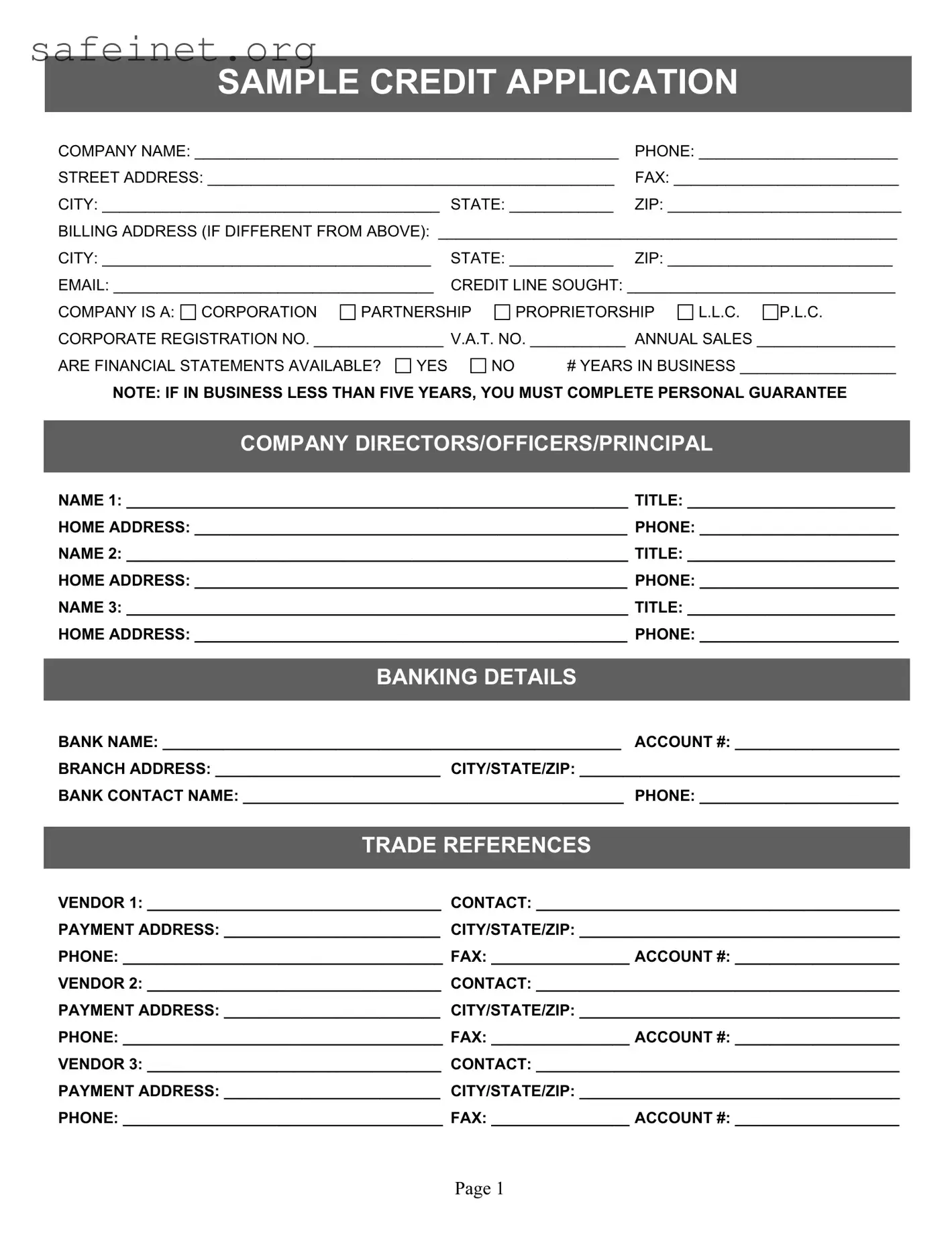SAMPLE CREDIT APPLICATION
COMPANY NAME: _________________________________________________ |
PHONE: _______________________ |
STREET ADDRESS: _______________________________________________ |
FAX: __________________________ |
CITY: _______________________________________ |
STATE: ____________ |
ZIP: ___________________________ |
BILLING ADDRESS (IF DIFFERENT FROM ABOVE): _____________________________________________________ |
CITY: ______________________________________ |
STATE: ____________ |
ZIP: __________________________ |
EMAIL: _____________________________________ |
CREDIT LINE SOUGHT: _______________________________ |
|
|
|
|
|
|
|
COMPANY IS A: CORPORATION |
PARTNERSHIP |
|
PROPRIETORSHIP |
L.L.C. |
P.L.C. |
CORPORATE REGISTRATION NO. _______________ V.A.T. NO. ___________ ANNUAL SALES ________________ |
ARE FINANCIAL STATEMENTS AVAILABLE? |
YES |
NO |
# YEARS IN BUSINESS __________________ |
NOTE: IF IN BUSINESS LESS THAN FIVE YEARS, YOU MUST COMPLETE PERSONAL GUARANTEE
COMPANY DIRECTORS/OFFICERS/PRINCIPAL
NAME 1: __________________________________________________________ TITLE: ________________________
HOME ADDRESS: __________________________________________________ PHONE: _______________________
NAME 2: __________________________________________________________ TITLE: ________________________
HOME ADDRESS: __________________________________________________ PHONE: _______________________
NAME 3: __________________________________________________________ TITLE: ________________________
HOME ADDRESS: __________________________________________________ PHONE: _______________________
BANKING DETAILS
BANK NAME: _____________________________________________________ ACCOUNT #: ___________________
BRANCH ADDRESS: __________________________ CITY/STATE/ZIP: _____________________________________
BANK CONTACT NAME: ____________________________________________ PHONE: _______________________
TRADE REFERENCES
VENDOR 1: __________________________________ CONTACT: __________________________________________
PAYMENT ADDRESS: _________________________ CITY/STATE/ZIP: _____________________________________
PHONE: _____________________________________ FAX: ________________ ACCOUNT #: ___________________
VENDOR 2: __________________________________ CONTACT: __________________________________________
PAYMENT ADDRESS: _________________________ CITY/STATE/ZIP: _____________________________________
PHONE: _____________________________________ FAX: ________________ ACCOUNT #: ___________________
VENDOR 3: __________________________________ CONTACT: __________________________________________
PAYMENT ADDRESS: _________________________ CITY/STATE/ZIP: _____________________________________
PHONE: _____________________________________ FAX: ________________ ACCOUNT #: ___________________
Page 1
CONDITIONS (TERMS ARE NET 30 DAYS UPON CREDIT APPROVAL)
TERMS OF SALE, INCLUDING TERMS OF PAYMENT AND CHARGES, FOR EACH PURCHASE ARE AGREED TO BE THOSE SPECIFIED ON THE FACE OF EACH INVOICE. THE CUSTOMER HEREBY AGREES TO PAY ALL COSTS OF COLLECTION OR LEGAL FEES SHOULD SUCH ACTION BE NECESSARY DUE TO NON-PAYMENT. THE ABOVE INFORMATION IS WILLINGLY SUPPLIED AND THE CREDITOR IS AUTHORIZED TO CONTACT THE ABOVE BANK AND TRADE REFERENCES IN ORDER TO ESTABLISH THE CREDITWORTHINESS OF THE ABOVE NAMED COMPANY. IF THE APPLICANT IS NOT A CORPORATION, THE CREDITOR IS AUTHORIZED TO OBTAIN CREDIT REPORTS ON THE PROPRIETORS, PARTNERS OR PRINCIPALS. SHOULD A CREDIT AVAILABILITY BE GRANTED BY THE CREDITOR, ALL DECISIONS WITH RESPECT TO THE EXTENSION OR CONTINUATION SHALL BE IN THE SOLE DISCRETION OF THE CREDITOR. THE CREDITOR MAY TERMINATE ANY CREDIT AVAILABILITY WITHIN ITS SOLE DISCRETION.
DISPUTES: ANY DISPUTE OR CONTROVERSY ARISING FROM THIS AGREEMENT WILL BE RESOLVED BY ARBITRATION BY THE AMERICAN ARBITRATION ASSOCIATION AT ORANGE COUNTY, CALIFORNIA. THE LANGUAGE OF THE ARBITRATION SHALL BE ENGLISH. THE NUMBER OF ARBITRATORS SHALL BE ONE. THE PARTIES AGREE THE AMERICAN ARBITRATION ASSOCIATION’S EXPEDITED RULES SHALL APPLY AND THEY WAIVE ALL RIGHT TO ANY HEARING REQUIRING WITNESS PRODUCTION. THE ARBITRATOR SHALL ISSUE AN AWARD BASED UPON THE WRITTEN DOCUMENTARY EVIDENCE SUPPLIED BY THE PARTIES. THE ARBITRATOR’S AWARD SHALL BE BINDING AND FINAL. THE LOSING PARTY SHALL PAY ALL ARBITRATION EXPENSES, INCLUDING ALL ATTORNEY’S FEES.
I HAVE READ AND UNDERSTAND THE ABOVE TERMS AND CONDITIONS, AND HEREBY AGREE TO THEM:
APPLICANT’S NAME: ______________________________________ TITLE: ________________________________
DATE: ______________________________________ APPLICANT’S SIGNATURE: ___________________________
FOR PROPRIETORS, PARTNERS, S-CORPORATIONS IN THE U.S.
I AUTHORIZE THE SELLER AND THEIR ASSIGNS TO OBTAIN A CONSUMER CREDIT REPORT ON MY CREDIT HISTORY.
DATE: ______________________________________ APPLICANT’S SIGNATURE: ____________________________
PERSONAL GUARANTEE
THE UNDERSIGNED, FOR CONSIDERATION DO HEREBY INDIVIDUALLY AND PERSONALLY GUARANTEE THE FULL AND PROMPT PAYMENT OF ALL INDEBTEDNESS HERETOFORE OR HEREAFTER INCURRED BY THE ABOVE BUSINESS. THIS GUARANTEE SHALL NOT BE AFFECTED BY THE AMOUNT OF CREDIT EXTENDED OR ANY CHANGE IN THE FORM OF SAID INDEBTEDNESS. NOTICE OF THE ACCEPTANCE OF THIS GUARANTEE, EXTENSION OF CREDIT, MODIFICATION IN TERMS OF PAYMENT, AND ANY RIGHT OR DEMAND TO PROCEED AGAINST THE PRINCIPAL DEBTOR IS HEREBY WAIVED. THIS GUARANTEE MAY ONLY BE REVOKED BY WRITTEN NOTICE WHICH SHALL BE SENT TO THE CREDITOR’S CREDIT OFFICE BY CERTIFIED MAIL. ANY REVOCATION DOES NOT REVOKE THE OBLIGATION OF THE GUARANTORS TO PROVIDE PAYMENT FOR INDEBTEDNESS INCURRED PRIOR TO THE REVOCATION. I AUTHORIZE THE SELLER AND THEIR ASSIGNS TO OBTAIN A CONSUMER CREDIT REPORT AND TO CONTACT MY REFERENCES AS NECESSARY. AS GUARANTOR, I AM ALSO BOUND BY THE ABOVE ARBITRATION CLAUSE.
GUARANTOR’S NAME: _____________________________________ |
SIGNATURE: __________________________ |
HOME ADDRESS: _____________________________ CITY/STATE/ZIP: ____________________________________ |
DATE: _______________________________________ TAX I.D. OR S.S. NO: _________________________________ |
GUARANTOR’S NAME: _____________________________________ |
SIGNATURE: __________________________ |
HOME ADDRESS: _____________________________ CITY/STATE/ZIP: ____________________________________
DATE: _______________________________________ TAX I.D. OR S.S. NO: _________________________________
Page 2


